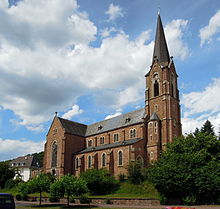St. Andreas (Reimsbach)
The Church of St. Andreas and Assumption of Mary is a Roman Catholic parish church in Reimsbach , a district of the Beckingen community , Merzig-Wadern district , Saarland . The church bears the patronage of St. Andrew and is listed as an individual monument in the Saarland monuments list.
history
The church was built between 1898 and 1901 according to plans by the architect Wilhelm Hector ( Saarbrücken-St. Johann ). In 1997 the interior of the church was restored under the direction of the architect Eugen Maringer ( Haustadt ).
The old parish church, built around 1750, was profaned .
Architecture and equipment
The church building, built in neo-Gothic style, is a three-aisled basilica . The nave , divided into a central nave and two lower aisles , is divided into four bays . A transept adjoins the nave and a five-sided choir with a polygonal finish. This results in the shape of a Latin cross as a floor plan . The ceilings of the three naves are formed by ribbed vaults. In the vaulted areas there are paintings with floral motifs.
The church was painted in 2009 by master painter Georg Werding (Reimsbach) and six employees. Old wall paintings were rediscovered and restored.
Noteworthy furnishings in the church are the Gothic high altar and the two side altars, also made in Gothic language, with numerous figures of saints and reliefs of biblical and sacred scenes. The three winged altars date from the time the church was built.
organ
The organ of the church was built in 1904 by Mamert Hock ( Saarlouis ). The pocket shop instrument is set up on a gallery and has 25 registers , divided into 2 manuals and pedal . The almost original performance and stop action mechanism is pneumatic.
It is the largest surviving organ from the Hock company, which is also one of the last examples of local organ building in the tonal and optical style of the turn of the 19th and 20th centuries. Century represents.
|
|
|
||||||||||||||||||||||||||||||||||||||||||||||||||||||||||||||||||||||||||||||||||||
-
Pairing :
- Normal coupling: II / I, I / P, II / P
- Sub-octave coupling: II / I
- Super octave coupling: I / I
- Playing aids : Piano, Mezzoforte, Forte, Tutti
literature
- Marschall, Kristine: Sacred buildings of classicism and historicism in Saarland . Institute for Regional Studies in Saarland, Saarbrücken 2002, ISBN 978-3-923877-40-9 , p. 666 .
Web links
Individual evidence
- ↑ a b List of monuments of the Saarland, partial list of monuments in the district of Merzig-Wadern (PDF; 285 kB), accessed on December 25, 2012
- ↑ a b c d e Information on the parish church of St. Andreas and Mariä Himmelfahrt Reimsbach at: www.kunstlexikonsaar.de, accessed on March 25, 2014
- ↑ Organ of the Church of St. Andrew and the Assumption of Mary On: de.organindex.org, accessed on December 25, 2012
- ↑ Renovation of the Hock organ in Reimsbach On: www.harald-staub.homepage.t-online.de, accessed on December 25, 2012
Coordinates: 49 ° 27 '2.5 " N , 6 ° 45' 55.7" E


